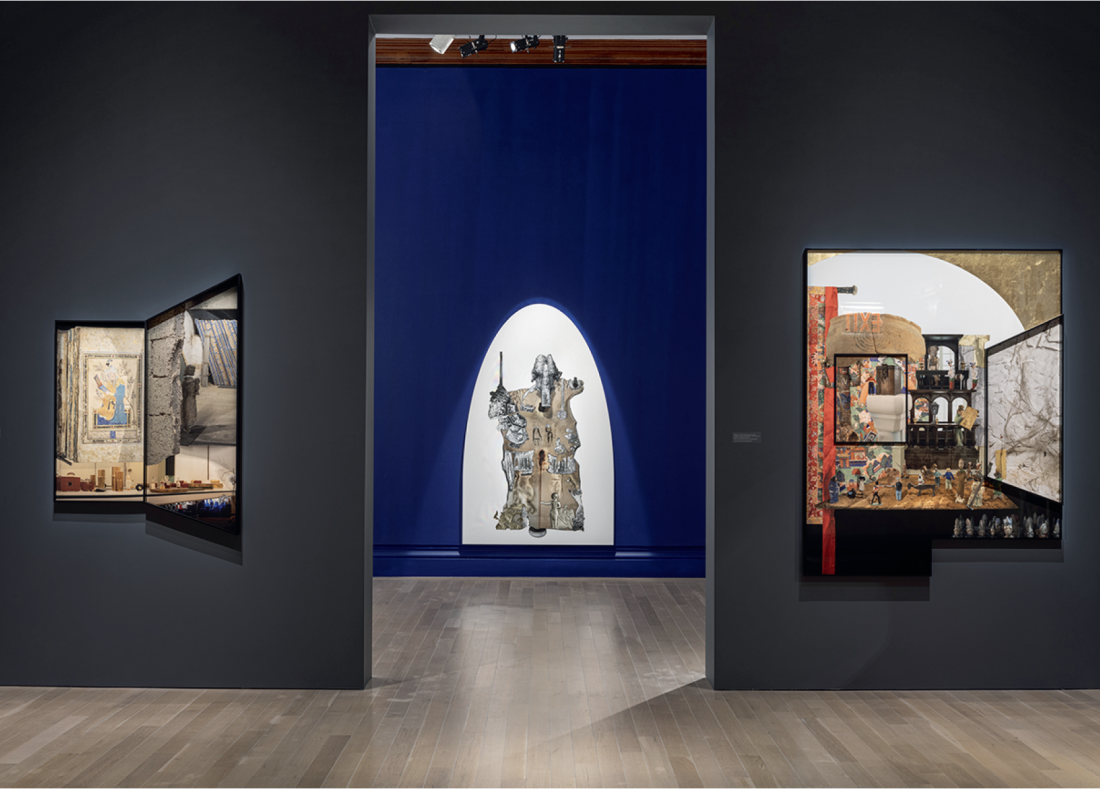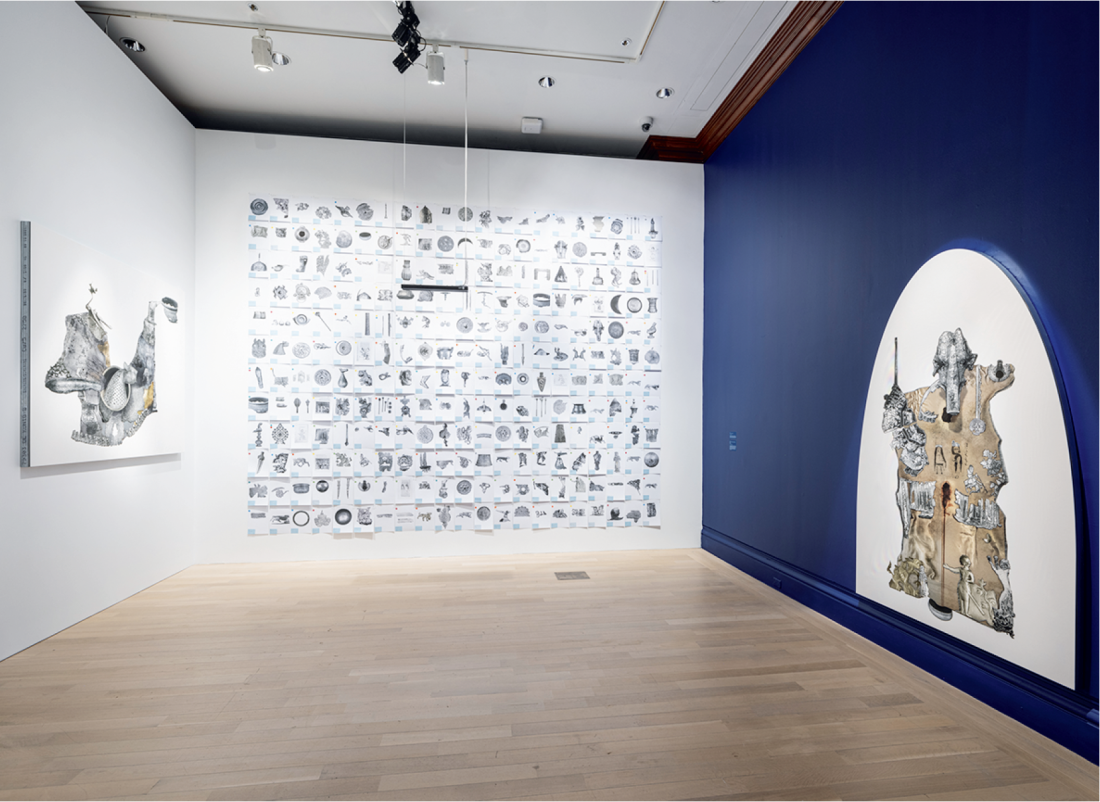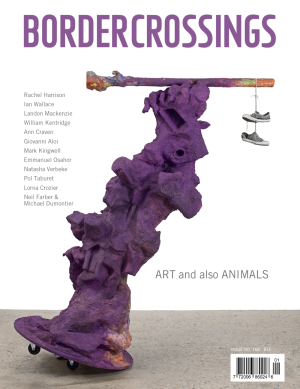Ilit Azoulay
How is the identity of a person defined? In part by mental qualities—by their personality, thoughts and beliefs. But personal identity is also defined by things that matter to us. Think how a child loves her favourite blanket and an art collector his favourite artwork. Ilit Azoulay’s art is about the relationship between persons and the things that matter to them. For that reason, her exhibition title, “Mere Things,” seems to me ironic. Her point is that the objects shown in her photographs do matter. In that way, they are much more than mere things. This, her first American museum exhibition, includes selections from four prior European and Israeli shows, “Tree For Too One,” 2010; “Shifting Degrees of Certainty,” 2014; “No Thing Dies,” 2017; and “Queendom,” 2022. And also some new works.

Ilit Azoulay, installation view, “Mere Things,” 2024– 2025, Jewish Museum, New York. Photo by Kris Graves. © Ilit Azoulay. Left to right: Vitrine No. 17: The life in her is limited to that side only, 2017, inkjet print, 138 × 98 centimetres. Collection of Tony and Trisja Podesta, Washington, DC; Queendom: Panel #3, 2022, inkjet print, 215 × 135 centimetres; Vitrine No. 14: One may ask, how, by what principle, does the world persist?, 2017, inkjet print and frame of medium density fibreboard, 174 × 136 centimetres.
“Tree For Too One” presents objects from the walls of buildings demolished in Tel Aviv to house newcomers to Israel in the late 1940s. “Shifting Degrees of Certainty” uses found objects from German historical sites. “No Thing Dies” has materials from the Israel Museum in Jerusalem, telling the story of emigrants to the Jewish State. “Queendom” draws on a study collection of photographs from the L.A. Mayer Museum for Islamic Art in Jerusalem, an archive created by David Storm Rice, 1913–1962, a Jewish art historian and archaeologist who gathered information about the medieval Islamic world. And Azoulay’s latest work, Unity Totem, 2024, is based upon the Jewish Museum’s collection of ritual objects, such as Torah ornaments and amulets, mostly created by Jewish communities in various parts of the Arab world, including those in the artist’s familial homeland of Morocco. This show demands close attention. There is a lot to see here, for in this show artifacts are gathered in a relatively small space.
Working with materials from diverse sites, Azoulay’s goal is to understand how these objects can be used to construct narratives. To understand her photographs, we need to know how the objects in her show are connected. For example, in Unity Totem, a green hat releases smoke like an incense cone, and around 20 photographs of objects from diasporic Jewish communities spiral outward from it. More exactly, she is concerned not merely to replicate the existing historical records but also to change how we understand how the world is connected. As the description on the website, with reference to “Queendom,” says: “By regendering existing figures and creating new composites, Azoulay invites the viewer to imagine a future matriarchy with deep roots in the past.” Her digital photo collages of archival objects explore how these assemblages of images transmit knowledge, shape memory and thus support historical narratives. From these mere things, our sense of selfhood is created.

Ilit Azoulay, installation view, “Mere Things,” 2024– 2025, Jewish Museum, New York. Photo by Kris Graves. © Ilit Azoulay. Left to right: Queendom: Panel # 6, 2022, inkjet print, 160 × 182 centimetres; collection of archive and research papers as part of the “Queendom” series; Queendom: Panel #3, 2022, inkjet print, 215 × 135 centimetres.
I confess to not entirely understanding this marvellously intriguing exhibition, which is a very serious, highly elusive philosophical exercise. It’s my sense that “Mere Things” has rich suggestive connections with Aby Warburg’s Bilderatlas, his famous assemblage of photographic images, with Walter Benjamin’s well-known accounts of collecting, and I think also with Hannah Arendt’s visionary account in The Human Condition of the role of material things in stabilizing human life experience. When we are presented with some “mere things,” what’s needed in all of these cases is to understand what the things mean to a particular person. What we need to know about Azoulay’s “mere things,” which is not always obvious, is why they were significant.
It’s no accident, I suspect, that like all three of these predecessors, Azoulay, too, who lives and works in Germany, is of Jewish ancestry. In highly creative, deeply personal ways, she builds upon and extends the modernist tradition. But that means—speaking just for myself— that it is not easy for an American audience to understand the ways of visual thinking that she employs so masterfully. I have only begun to fully comprehend the intricate, immensely suggestive analysis that Azoulay provides. ❚
“Ilit Azoulay: Mere Things” was exhibited at the Jewish Museum, New York, from September 13, 2024, to January 5, 2025.
David Carrier’s most recent book is Philosophical Skepticism as the Subject of Art: Maria Bussmann’s Drawings, 2022. His In Caravaggio’s Shadow: Naples as a Work of Art, 2025, is forthcoming.

